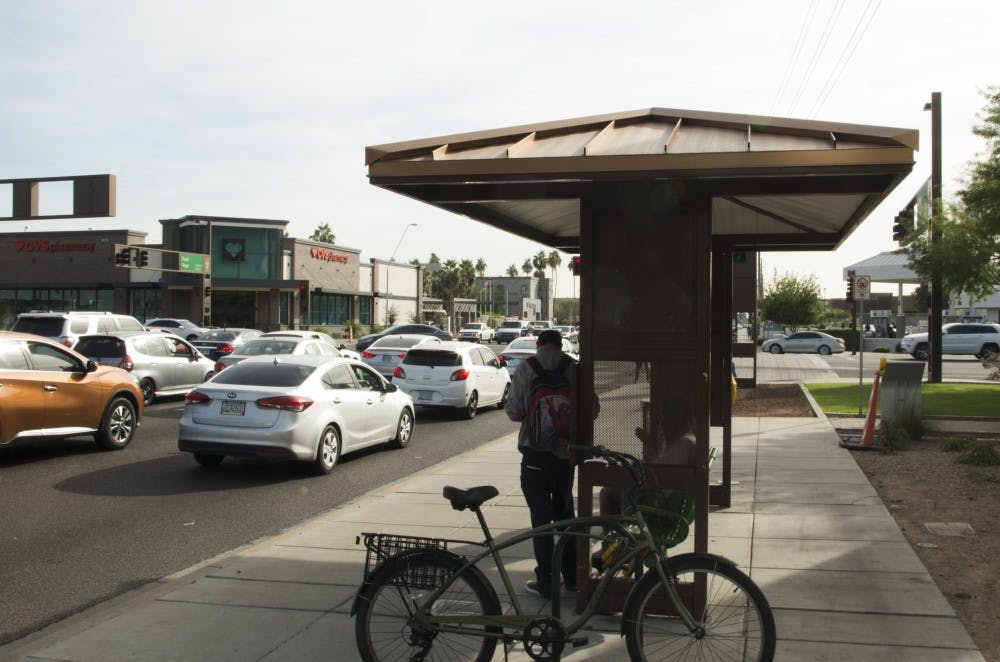ASU has completed its heat test and study in partnership with 3M and the city of Tempe to potentially create cooler, more comfortable bus shelters.
The study conducted by David Sailor, a professor at the School of Geographical Sciences and Urban Planning and the director of the Urban Climate Research Center, and his team was an attempt to understand how excess heat affects the environment as well as to develop effective strategies to mitigate that excess heat in cities.
The study found that the shelters with a reflective film developed by 3M were, on average, 1 degree Fahrenheit cooler than the outside air temperature and cooler than those without the film. The team found that the shelters without the film were about 6.5 degrees hotter than those with it.
3M, a company that works with different materials to create technology for places like schools, businesses, hospitals and other industries, provided polymeric reflectors, the film that ASU used in the study. The film is placed over the bus shelters and, essentially, reflects the energy of sunlight back towards space.
After installing the 3M film on three shelters in December 2020, with another three without the film as the control, all in Tempe, Sailor and his team gathered data over a period of nine months. The team used one sensor that was attached to the underside of the shelter to measure its temperature and a wire from the sensor left out to measure the air temperature to compare.
"We would monitor the thermal conditions of the shelters both with and without the film technology on the order of nine months and really evaluate how effective these are and if they really work," Sailor said. "The idea being that the bus shelters being proof of concept of what we really want to do and use these kinds of materials in the urban environment."
The average surface temperatures were recorded throughout the day, but at certain times the surface temperature difference was somewhere between 20 and 25 degrees, Sailor said.
"What we found was that underneath these cool film shelters, people would be experiencing on the order of a 4-degrees Fahrenheit reduction in what's known as the mean radiant temperature in the middle of the day," Sailor said.
Even with the 3M film, on days where the high was around 110 degrees, the bus shelters were still hotter than the ambient air temperature, the study found.
In future projects and with new materials, the hope is that the temperature of the shelters could be below the ambient air temperature at all hours of the day, Sailor said.
ASU partnered with 3M and Tempe to first see if they could cool down the bus shelters given the city has the "highest per capita ridership in the region," said TaiAnna Yee, a Tempe spokesperson for transportation.
Yee said Tempe is looking to redesign its bus shelters, with a goal to determine if applying the 3M film would make the shelters cooler for the bus riders waiting under them.
"(The new design) was not only supposed to be eye-catching, a new design for transit, and sustainable, but also have some kind of shade element to it," Yee said.
Tim Hebrink, a staff scientist at a 3M corporate research lab, said that after analyzing the data from the study, 3M has been working on two new generations of their polymeric reflectors.
While one of these new films is created to appeal to aesthetics by having a white theme, the other film has been created to be more reflective, thus making its performance higher than that of what was used for the study.
"One (of the new films) is more reflective, higher-performing than the one we provided to ASU and the city of Tempe," Hebrink said. "And then we have a third version that is made to be aesthetically pleasing. It doesn't have higher performance but looks like white paint to be used more where aesthetics are important."
The city of Tempe has yet to determine if they will use any version of the 3M film on their bus shelter redesign, according to Yee.
"We still have to research it to see if it is feasible to do," Yee said. "We would have to look into the cost to install it and also to keep it up. It is something that we are considering but we have to get more information first."
Reach the reporters at ljchatha@asu.edu and follow @LukeJC2 on Twitter.
Like The State Press on Facebook and follow @statepress on Twitter.
Continue supporting student journalism and donate to The State Press today.

Luke Chatham is a Community & Culture reporter and previous Business and Tech reporter. He also worked in the studio production crew for Cronkite News and is currently a freelance reporter and writer for Arcadia News.




